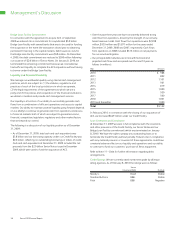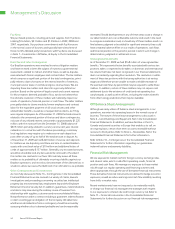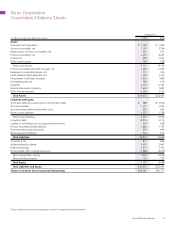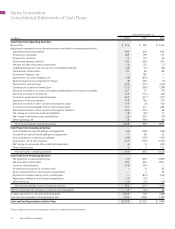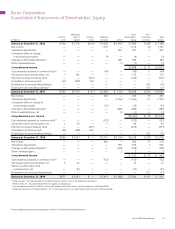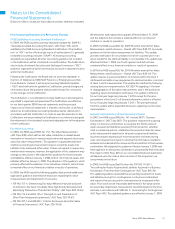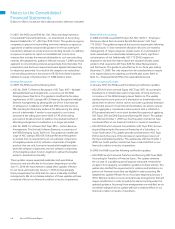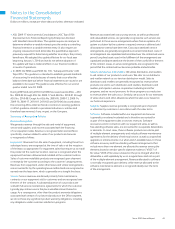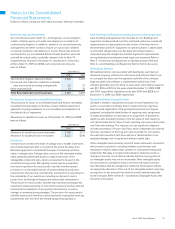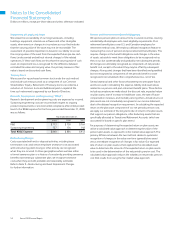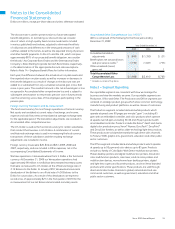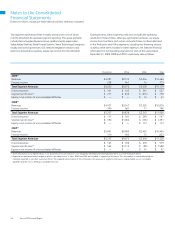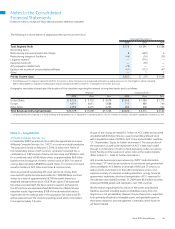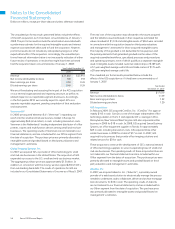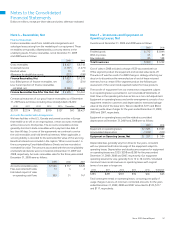Xerox 2009 Annual Report Download - page 50
Download and view the complete annual report
Please find page 50 of the 2009 Xerox annual report below. You can navigate through the pages in the report by either clicking on the pages listed below, or by using the keyword search tool below to find specific information within the annual report.
48 Xerox 2009 Annual Report
Notes to the Consolidated
Financial Statements
Dollars in millions, except per-share data and unless otherwise indicated.
Benefit Plans Accounting
In 2008, the FASB issued Staff Position No. FAS 132(R)-1, “Employers’
Disclosures about Post-retirement Benefit Plan Assets” (ASC Topic
715-20-65). This guidance expands disclosure by requiring the following
new disclosures: 1) how investment allocation decisions are made by
management; 2) major categories of plan assets; 3) a roll-forward of
assets valued with non-observable market inputs; and 4) significant
concentrations of risk. Additionally, ASC 715-20-65 requires an
employer to disclose information about the valuation of plan assets
similar to that required in ASC Topic 820 Fair Value Measurements
and Disclosures. This guidance was effective for our fiscal year ending
December 31, 2009. The only impact from this standard was to require
us to expand disclosures regarding our benefit plan assets. Refer to
Note 14 – Employee Benefit Plans for expanded disclosures.
Other Accounting Changes
In January 2010, the FASB issued the following Codification updates:
•ASU 2010-01 which amends Equity (ASC Topic 505): Accounting for
Distributions to Shareholders with Components of Stock and Cash –
a consensus of the FASB Emerging Issues Task Force. This update
clarifies that the stock portion of a distribution to shareholders that
allows them to elect to receive cash or stock with a potential limitation
on the total amount of cash that all shareholders can elect to receive
in the aggregate is considered a share issuance that is reflected in
EPS prospectively and is not a stock dividend for purposes of applying
ASC Topics 505 and 260 (Equity and Earnings Per Share). This update
was effective October 1, 2009 (our fourth quarter) and did not have
a material effect on our financial condition or results of operations.
•ASU 2010-02 which amends Consolidation (ASC Topic 810): Accoun-
ting and Reporting for Decreases in Ownership of a Subsidiary – a
Scope Clarification. This update provides amendments to ASC Topic
810 to clarify the scope of the decrease in ownership provisions of
the topic and related guidance. This update was effective October 1,
2009 (our fourth quarter) and did not have a material effect on our
financial condition or results of operations.
In 2009, the FASB issued the following codification updates:
•ASU 2009-16 which amends Transfers and Servicing (ASC Topic 860):
Accounting for Transfers of Financial Assets. This update removed
the concept of a qualifying special-purpose entity and removed the
exception from applying consolidation guidance to these entities. This
update also clarified the requirements for isolation and limitations on
portions of financial assets that are eligible for sale accounting. We
adopted this update effective for our fiscal year beginning January 1,
2010. We have certain accounts receivable sale arrangements that will
require modification in order to qualify for sale accounting under this
updated guidance. Assuming those arrangements are modified, we do
not believe adoption of this update will have a material effect on our
financial condition or results of operations.
In 2007, the FASB issued SFAS No. 160, “Noncontrolling Interests in
Consolidated Financial Statements – an amendment of Accounting
Research Bulletin No. 51” (ASC Topic 810-10-65). This guidance requires
companies to present noncontrolling (minority) interests as equity (as
opposed to a liability) and provides guidance on the accounting for
transactions between an entity and noncontrolling interests. In addition,
it requires companies to report a consolidated net income (loss)
measure that includes the amount attributable to such noncontrolling
interests. We adopted this guidance effective January 1, 2009, and have
applied it to noncontrolling interests prospectively from that date. The
presentation and disclosure requirements were applied retrospectively
for all periods presented. As a result of this adoption, we reclassified
noncontrolling interests in the amount of $120 from Other long-term
liabilities to equity in the December 31, 2008 balance sheet.
Revenue Recognition
In 2009, the FASB issued the following ASUs:
•ASU No. 2009-13, Revenue Recognition (ASC Topic 605) – Multiple-
Deliverable Revenue Arrangements, a consensus of the FASB
Emerging Issues Task Force. This guidance modifies the fair value
requirements of ASC subtopic 605-25 Revenue Recognition-Multiple
Element Arrangements by allowing the use of the “best estimate
of selling price” in addition to VSOE and VOE (now referred to as
TPE, standing for third-party evidence) for determining the selling
price of a deliverable. A vendor is now required to use its best
estimate of the selling price when VSOE or TPE of the selling
price cannot be determined. In addition, the residual method of
allocating arrangement consideration is no longer permitted.
•ASU No. 2009-14, Software (ASC Topic 985) – Certain Revenue
Arrange ments That Include Software Elements, a consensus of
the FASB Emerging Issues Task Force. This guidance modifies the
scope of ASC subtopic 985-605 Software-Revenue Recognition
to exclude from its requirements (a) non-software components
of tangible products and (b) software components of tangible
products that are sold, licensed or leased with tangible products
when the software components and non-software components
of the tangible product function together to deliver the tangible
product’s essential functionality.
These updates require expanded qualitative and quantitative
disclosures and are effective for fiscal years beginning on or after
June 15, 2010. We have elected to adopt these updates effective
for our fiscal year beginning January 1, 2010 and we will apply
them prospectively from that date for new or materially modified
arrangements. We do not believe adoption of these updates will have
a material effect on our financial condition or results of operations.


